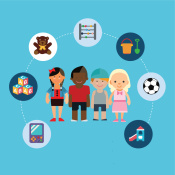Critical Information
The number of children ages 3 to 17 struggling with anxiety or depression rose by 1.5 million between 2016 and 2020. Educators trained in resilience will fortify their students and raise their potential for learning.
Two modes for promoting student resilience
Synchronous solutions…
include facilitated small group discussion, coaching, workshops, and more. Our unique web events include live group therapy, humor workshops to infuse fun into the classroom and even live events with comedians. Enjoy the video example.
Asynchronous solutions…
include on-demand video engagements on a range of topics from autism to dealing with difficult students. Faculty (and parents) can learn the rubric for developing greater resilience, will pass along this learning to students. Please enjoy this video montage on student engagement from our on-demand video library.
On-demand virtual engagements

Cyberbullying Part I
Online, mobile, and social media technology related aggression is on the rise. Learn how to identify the impact of cyberbullying when it occurs outside the school.

Dealing with Difficult Students Part I
The potential disruption of a single student can be massive. This set of courses is designed to turn around these types of students.

Dealing with Difficult Students Part II
This course helps you explore underlying influences in problematic behavior while helping you realize what buttons get pushed within you.

Dealing with Difficult Students Part III
Take this course to explore addressing problematic behavior in the moment or in private. Learn some important guidelines in addressing disruptive students.

Dealing with Difficult Students Part IV
This course offers a series of progressive steps to help this student become more engaged and cooperative while minimizing the risk of further entrenchment.

Decision Making at Work
Bias can be a strong but invisible force in decision making. Learn how to recognize biased decision making with Dr. Bell, who shares years of consulting with corporate America.

Differentiated Instruction Part I
Differentiated Instruction (DI) is a commonly used phrase in education with various meanings. Learn from this superintendent a common language for meeting student goals.

Differentiated Instruction Part III
The final engagement in this series addresses advanced students and the SAMR system of learning. Academic engagement in diverse classrooms considered.
Success Stories

"Whole School Health Through Psychosocial Emotional Learning highlights the importance of relationships, communication, and compassion for others. It presents a critical view in supporting, training, and retaining teachers through the lens of engaging and modeling behaviors that will help our rural students be better civic leaders and community members. My favorite quote from the book gives credit to the author's upbringing and modeling from his parents: 'We must experience the world through others so we can fully engage in educating all children. My father and mother modeled to me and my siblings how to experience the world through somebody else’s eyes, especially if their outer differences stirred up discomfort or displeasure, enriching all lives involved.' I recommend all leaders, teachers, and stakeholders secure their copy as they prepare for school."
Allen Pratt, Executive Director, National Rural Education Association (NREA)